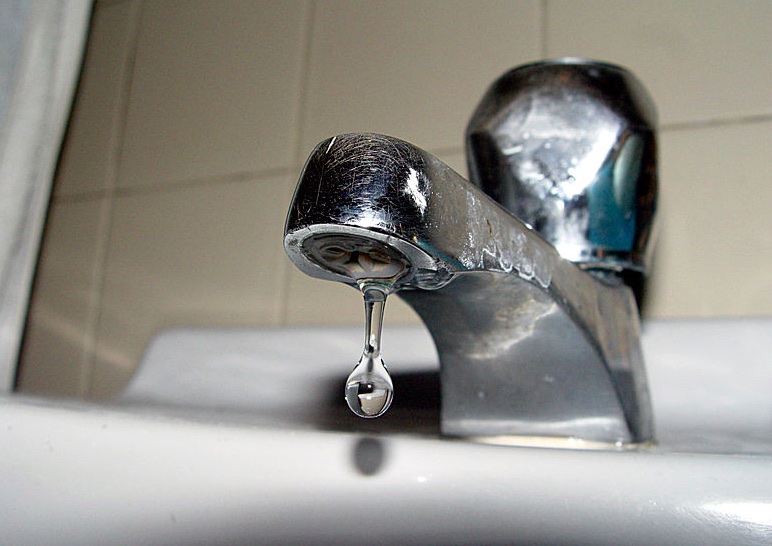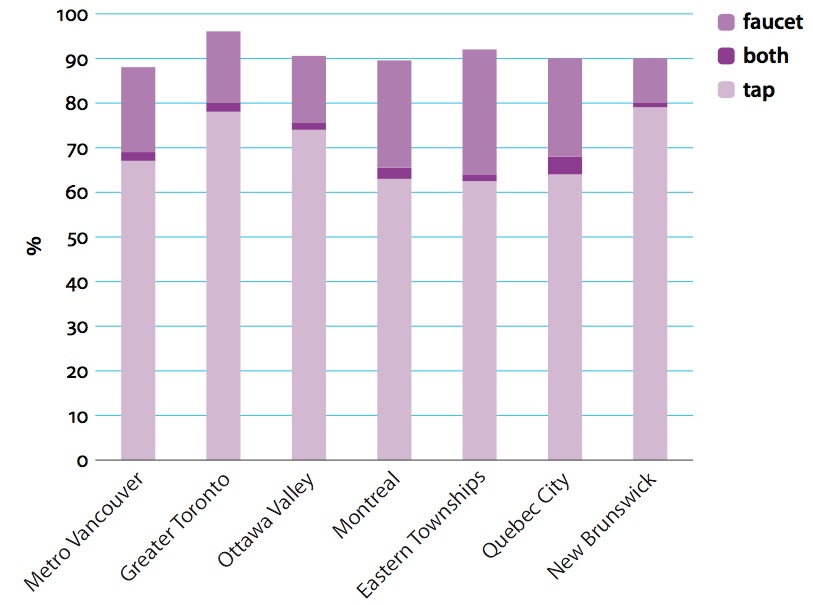Quick links
tap
DCHP-2 (Aug 2014)
n. — originally Construction
a device with valve controlling the flow of water, usually over a sink (see Image 1).
Type: 2. Preservation — Tap in this sense refers to the device used to regulate the flow of water, which is also called a "faucet" or "spigot", especially in many American locations. Boberg (2005: 46, Table 5) notes that today tap is the majority variant in Canada over the predominantly American variant "faucet", which is a minor variant in Canada.
It is common for tap to be used attributively in the compound noun tap water to distinguish it from bottled water (see the 2007 quotation). This use is international. However, the status of tap 'faucet', as in "to turn on the tap to let the water run" is a preserved lexical item from British English (see EDD, s.v. "tap" (sb.2)). Chambers (2008) offers comparative Canada-US data (see Chart 1, from Dollinger 2015b: Figure 4.3). As Chart 1 shows, tap is the majority term in all seven Canadian regions, which is not the case, quite on the contrary, on the American side, where tap does not even reach 20 percent and where "faucet" is the most common term.
Chambers (2008: 18) argues that the difference between Canada and the US came with increased immigration from Britain in the mid-1800s. Dollinger (2015b: 98) adds that indoor plumbing became widely available at a time when "British immigration had brought the British term for the appliance: tap", adding that "Canadian-British trade relations probably solidified the use of the non-American term in Canada". Charts 2 and 3 offer further evidence for this claim. While the phrase "from the tap" includes a number of contexts (e.g. beer) where the term is in use in the US, still the use in the US is half that of Canada. One can also see that the favoured British term is used in other parts of the Commonwealth and thus marks a success story of trade in the British Empire that exported not just the goods, but the terms, such as tap, with it.
COD-2 defines the term (n1 (1)), but does not label it.
It is common for tap to be used attributively in the compound noun tap water to distinguish it from bottled water (see the 2007 quotation). This use is international. However, the status of tap 'faucet', as in "to turn on the tap to let the water run" is a preserved lexical item from British English (see EDD, s.v. "tap" (sb.2)). Chambers (2008) offers comparative Canada-US data (see Chart 1, from Dollinger 2015b: Figure 4.3). As Chart 1 shows, tap is the majority term in all seven Canadian regions, which is not the case, quite on the contrary, on the American side, where tap does not even reach 20 percent and where "faucet" is the most common term.
Chambers (2008: 18) argues that the difference between Canada and the US came with increased immigration from Britain in the mid-1800s. Dollinger (2015b: 98) adds that indoor plumbing became widely available at a time when "British immigration had brought the British term for the appliance: tap", adding that "Canadian-British trade relations probably solidified the use of the non-American term in Canada". Charts 2 and 3 offer further evidence for this claim. While the phrase "from the tap" includes a number of contexts (e.g. beer) where the term is in use in the US, still the use in the US is half that of Canada. One can also see that the favoured British term is used in other parts of the Commonwealth and thus marks a success story of trade in the British Empire that exported not just the goods, but the terms, such as tap, with it.
COD-2 defines the term (n1 (1)), but does not label it.
Quotations
1870
Now, although the quantity of living spores, &c., may be got rid of by boiling or filtering at home, &c., how many a person is there who gets up at night in the dark, goes to get a glass of water, and prefers to obtain it "fresh from the tap" instead of drinking what has been standing hours in his sleeping appartment absorbing the gasses given off by the occupants asleep, and in this cup of fresh water drinks the seeds of future parasitic disease.
1881
The samples were taken from Hanlan's Point, from both outside and inside the crib, which is the present source of supply, from the well on the Engine House Wharf, from the pumping well, and from the tap in the School of Science.
1902
There is a limit beyond which, of course, the use of water is waste. There is no excuse for allowing the city's own mains to leak, the water therefrom saturating the soil and producing moisture and miasma, which may be productive of disease. But there is little sympathy with the spirit of restriction which would prevent the citizen letting the tap run while washing his hands, or restrain him from giving the plug of the flush tank in his bathroom a second pull because Mrs. Gamp thinks one pull is enough.
1916
A tap or faucet may be placed at the bottom of the barrel, through which the hot water may be drawn off.
1922
The average citizen in drinking a glass of water drawn from the tap in his home does so with the assurance that he is drinking pure water.
1950
So then, very much confused, but damned if he'd admit it, he sauntered over to the water tap by his table, washed a clean test tube and nonchalantly went to the compressed air jet to dry it.
1972
The lack of heating resulted in the lack of anything from the cold water tap and the cold spell two weeks ago froze the hot water pipe.
1986
It was 1954, when I was developing a series called Living, with Elaine Grand, when the notion arose that the program might include something like a TV handyman. Keith Morrow, then head of the farm broadcast department, mentioned [Peter] Whittall to me, and he was invited to take part in a dry run. His test project was to show how to fix a leaky tap.
2007
Cover the top of the barrel with a screen or mesh to keep out debris and mosquitoes. Make sure the screen is narrow enough to keep the 'skeeters' out. Adding a tap or spigot can make dispensing the water easier. Rainwater does not contain chlorine or other chemicals found in city water. Plants really enjoy getting watered with rainwater.
2014
Your camellia roots probably got burned or poisoned by the products that dripped on it. Repotting it immediately would have been a daunting prospect with a shrub that old, but if the roots were washed and repotted in all new soil, it might have lived. If a similar accident ever happens again to a big, old potted plant, try putting it under an outside tap on a slow drip for a few days.
References
- Boberg (2005)
- EDD
- Dollinger (2015b)
- Chambers (2008)
- COD-2
Images

Image 1: A tap (faucet). Source: Wikimedia Commons. Photo: Á. González
